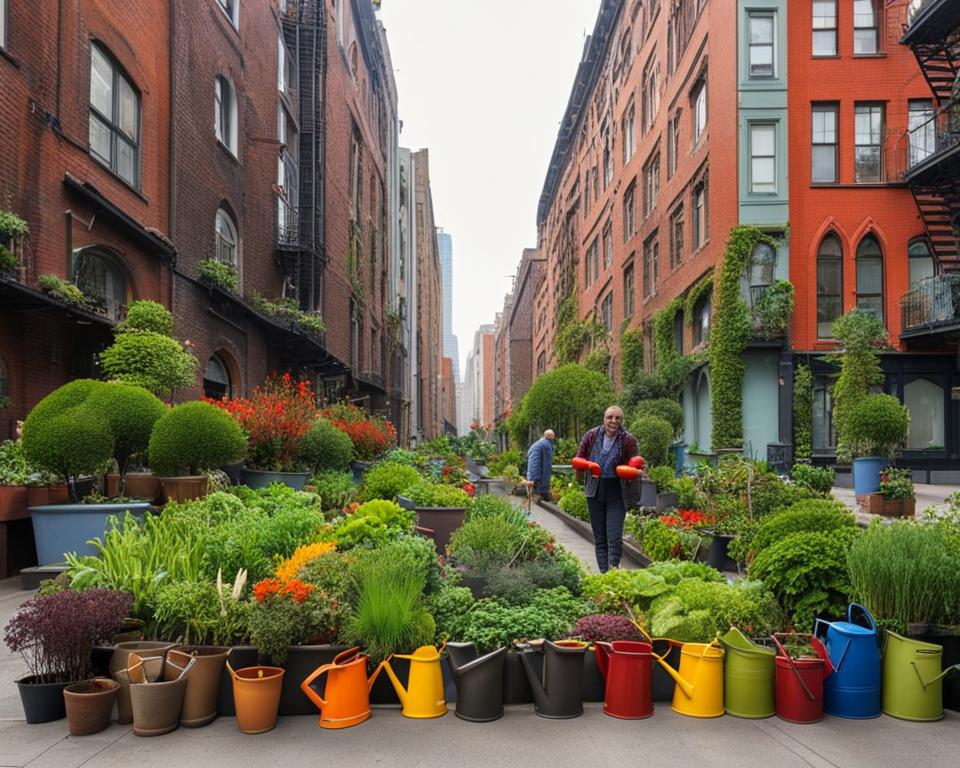Welcome, green thumbs-in-training! If you’ve ever yearned to harvest your own juicy tomatoes or relax with a book surrounded by fragrant basil and pansies, then you’re ready to embark on the rewarding journey of urban gardening for beginners. Perfect for busy city life, urban gardening lets you carve out a verdant refuge amid bustling streets—reaping the many urban gardening benefits along the way.
No sprawling backyard? No problem. We’re here to demystify urban gardening how-to so you can transform even the tiniest of spaces into a lush, productive haven. With a dash of creativity and a sprinkle of effort, let’s seed the foundations of your very own garden oasis!
Key Takeaways
- Urban gardening is an accessible and enriching pursuit tailored for city dwellers.
- It offers fresh produce, a relaxing atmosphere, and a sustainable lifestyle.
- Starting your urban garden begins with understanding the basics and choosing the right plants.
- Maximizing space through container and vertical gardening techniques is key.
- With the right approach, even beginners can enjoy the beauties of nature within urban settings.
- Embrace the peace and personal fulfillment that comes from cultivating your urban oasis.
Embracing Urban Gardening: A Beginner’s Guide
Delving into the world of urban gardening can be a transformative experience, providing a touch of greenery in the concrete confines of city living. Whether you’re looking to grow your own fresh herbs or beautify your balcony, this beginner’s guide to urban gardening will walk you through the essentials. You’ll discover practical urban gardening ideas that suit your lifestyle and learn how to establish a verdant haven in the heart of the city. Let’s cultivate your green thumb and turn your urban space into a flourishing garden.
Understanding the Basics of Urban Gardening
Urban gardening essentials begin with knowing the fundamentals. Acquainting yourself with the soil types, water requirements, and the right gardening tools marks the inception of your green journey. Recognizing the significance of these basic elements ensures your urban garden not just survives but thrives amidst the bustling city life. Dedication and a bit of patience are your allies as you embark on this verdant quest.
Selecting Suitable Plants for City Environments
Your choice of plants can make or break your gardening endeavor. Opt for resilient varieties like basil, spinach, tomatoes, and peppers, which not only cope with the shifting urban conditions but also promise a bounty of fresh produce. Here’s a secret: think perennial herbs and leafy greens, perfect for continual harvests and adaptable to the shifting shades of the cityscape.
Identifying the Perfect Spot for Your Urban Garden
Scour your urban dwelling for that sweet spot – a balcony, windowsill, or even a small patio can transform into your verdant sanctuary. Sunlight is your plant’s best friend, so seek out locations that bask in its glow. Remember, even the smallest nook can harbor a plethora of pots, brimming with green life and the fresh aroma of herbs.
As you familiarize yourself with the ins and outs of city plant cultivation, consider this beginner’s guide to urban gardening as the map leading to your hidden treasure—a lush urban garden. With dedication, a sprinkle of creativity, and this foundational knowledge, you’re well on your way to becoming an urban gardening aficionado.
The Essentials of Container Gardening in Urban Spaces
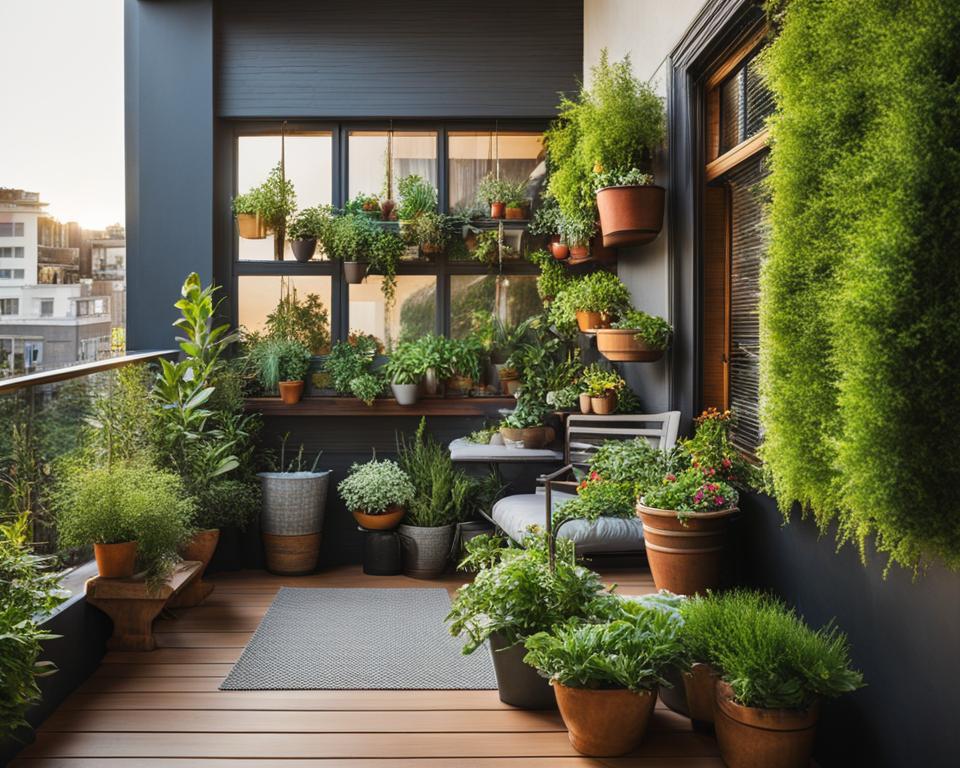
Container gardening is an innovative approach that makes urban gardening sustainability a reality for apartment dwellers and those with limited outdoor space. By embracing urban gardening techniques and harnessing the versatility of container gardening, you can transform your balcony or windowsill into a thriving garden that not only adds a splash of green to the concrete jungle but also contributes to your self-sufficiency and ecological well-being.
Choosing the Right Containers for Your Plants
The key to a successful container garden lies in selecting the right vessels for your plants. Various containers, from classic ceramic pots to innovative hanging baskets, can be employed to suit the needs of your urban garden. It’s essential to consider factors like size, material, and compatibility with the plant varieties you wish to grow, such as compact herbs or cherry tomatoes tailored for an urban setting. A wide array of containers allows you to customize your garden to your unique taste and functional requirements.
The Importance of Proper Drainage
Proper drainage is a cornerstone of container gardening. Without it, plants are at risk of waterlogging, which can lead to root rot and other detrimental conditions. Ensuring that each container has adequate drainage holes is a non-negotiable aspect of garden planning. A well-drained pot coupled with suitable soil and mindful watering practices are instrumental in cultivating a vibrant and resilient urban garden.
| Container Type | Best Used For | Material Considerations | Drainage Tips |
|---|---|---|---|
| Ceramic Pots | Herbs, Flowers | Porous, offers breathability | Ensure bottom holes; add gravel layer |
| Plastic Planters | Vegetables, Annuals | Lightweight, retains moisture | Multiple holes required; consider a drip tray |
| Wooden Boxes | Small Fruit Bushes, Perennials | Natural look, insulates roots | Line with plastic to prevent rot; drill holes |
| Hanging Baskets | Vining Plants, Spillers | Can dry out quickly; choose moisture-retentive liners | Add holes in sides for even watering if needed |
| Fabric Grow Bags | Root Vegetables, Portable gardens | Prevents overwatering, promotes air pruning | Superior drainage; may not need additional holes |
| Self-Watering Planters | Busy Gardener’s Choice | Reservoir-based; careful of overwatering | Check reservoir doesn’t overflow and allows aeration |
Maximizing Small Spaces: Vertical Gardening Techniques
Discover vertical gardening, a revolutionizing concept that has changed the way urban dwellers approach small space gardening. Given the limited ground area in urban environments, looking up opens a new horizon for urban gardeners. By utilizing vertical surfaces, you can significantly expand your green space without expanding your footprint.
Let’s dive into some practical urban gardening tips to help you make the most out of your available space:
- Wall Planters: Turn a bare wall into a living work of art with a variety of wall planters that cater to all kinds of plants, from succulents to herbs.
- Repurposed Pallets: Wooden pallets can be easily transformed into vertical gardens and serve as perfect backdrops for sprawling vines or a colorful array of flowers.
- Stackable Planters: Invest in stackable planters which allow you to grow multiple plants in a single tower-like structure, thus economizing on space.
- Trellises: Use trellises for climbing plants such as cucumbers, peas, and certain types of flowers to create not only a garden but also a stunning visual display.
Optimizing your garden with vertical gardening techniques doesn’t just save space; it also adds an extra layer of beauty to your urban home. Vining plants like cucumbers and cherry tomatoes are perfect for your new vertical setup, flourishing upward and offering a fresh, bountiful harvest.
Get creative with small space gardening — the sky’s the limit when it comes to the variety of plants that can adapt to vertical growth. With these strategies in mind, you’ll transform any cramped space into a lush, vertical garden oasis.
Urban Gardening How-To: Cultivating a Community Garden Experience
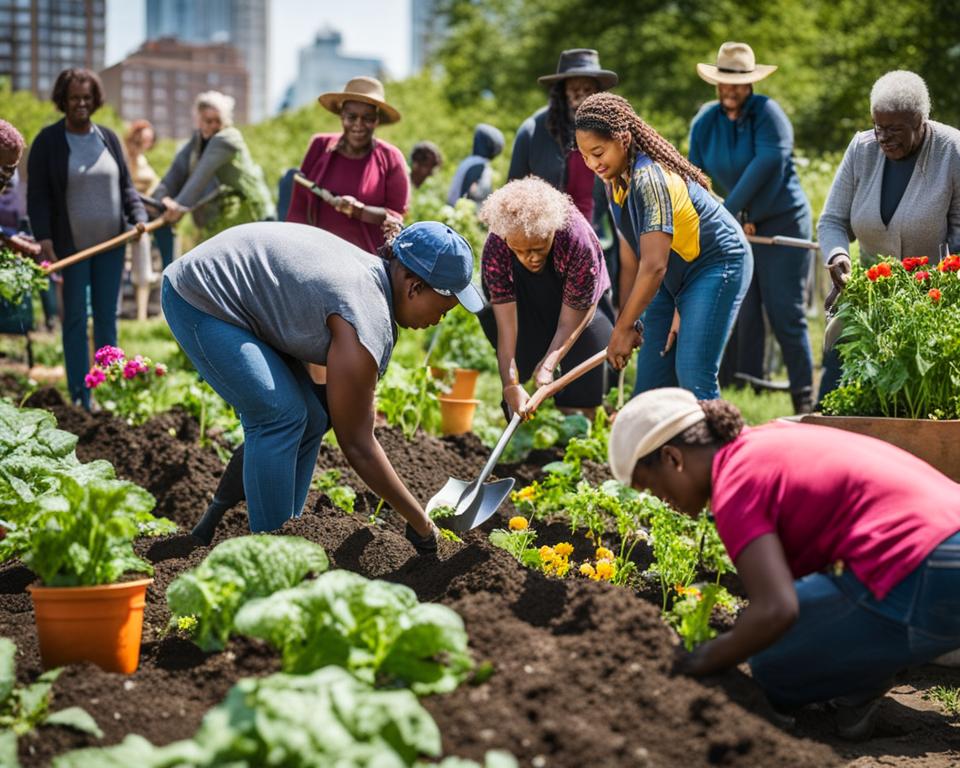
Embarking on the adventure of community gardening can transform an individual’s urban living experience. It’s not simply about planting seeds, it’s about cultivating a garden oasis where community members connect and collaborate. With the burgeoning trend of urban dwellers seeking a touch of verdancy, community gardens offer a unique opportunity to engage with urban gardening ideas and share in the bounty of collective effort.
Benefits of Community Gardening
Inviting you to dig deeper into the soil, community gardens serve as a nurturing ground for more than just plants. These collaborative spaces are pivotal for teaching sustainable living practices, sharing valuable gardening knowledge, and enhancing neighborhood cohesion. By participating, you immerse yourself in a nurturing environment that contributes to personal well-being and the beautification of your urban space.
How to Get Involved in Local Community Gardens
Ready to join the green movement? Getting involved in a local community garden is typically straightforward. It usually involves reaching out to the organization that manages the garden, signing up, and sometimes a nominal fee or volunteer time. Seeing a seed you planted blossom into a full-grown plant becomes a rewarding testament to your contribution to the local ecosystem.
- Connect with Your Local Council: They often have information on nearby community gardening spaces and how to participate.
- Attend Gardening Workshops or Events: These gatherings are great for meeting fellow gardening enthusiasts and finding out about the community garden scene.
- Volunteer: Even if you don’t have a green thumb, offering your time can be a great way to get involved and learn.
As you come together with neighbors to till, plant, and harvest, you’re not only cultivating a garden oasis, but you’re also sowing the seeds for a stronger, greener community.
Transforming Windowsills into Productive Gardens
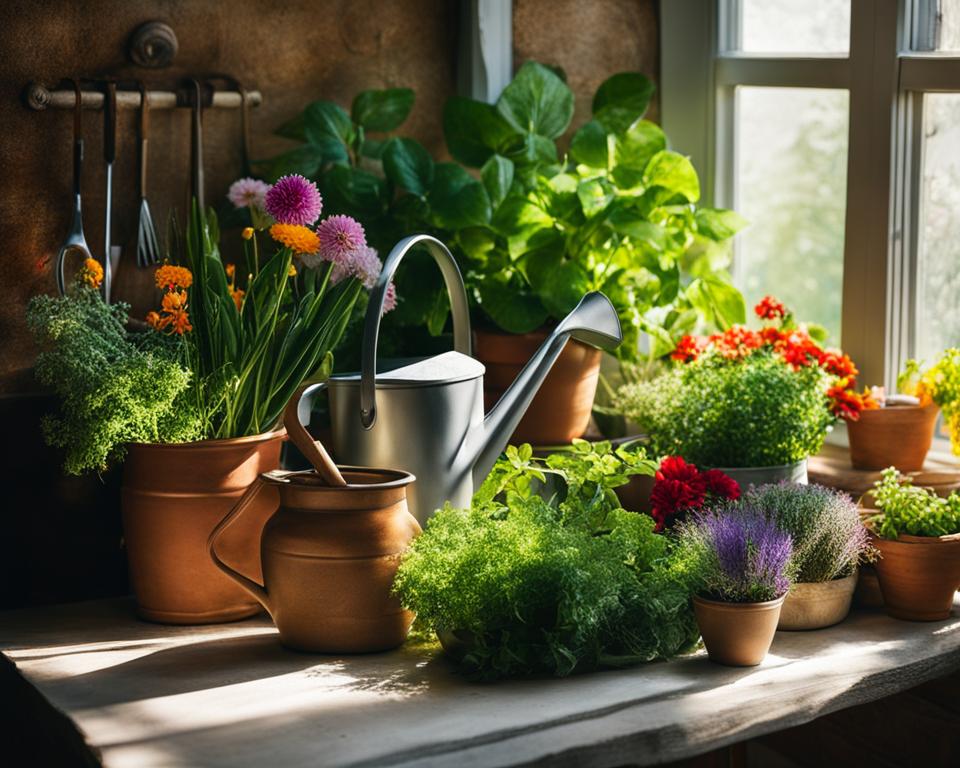
With urban spaces often being compact and outdoor areas a luxury, windowsill gardening becomes an ingenious solution. It’s a brilliant example of urban gardening how to make the most of limited spaces. Not only do they provide a platform for practical gardening techniques, but they also take full advantage of the natural light that graces your windows.
Imagine savoring your morning coffee next to a lush miniature garden, bustling with aromatic herbs and colorful cherry tomatoes. By exploiting every inch of your windowsill, you can bring nature’s vibrancy into your daily life. Follow these steps to embark on your windowsill gardening adventure:
- Assess the sunlight that hits your windowsill to determine suitable plant varieties. Herbs like basil, chives, and mint are excellent starters.
- Select containers with adequate drainage to promote healthy root systems.
- Opt for high-quality soil, rich in nutrients, to provide your plants with a vigorous beginning.
Your windowsill can be more than just a perch for your favorite knick-knacks; it’s potential waiting to be unlocked for fresh, homegrown produce. Below is a table for some popular plants that thrive in the unique environment of a windowsill:
| Plant | Light Requirement | Watering Frequency | Special Care Tips |
|---|---|---|---|
| Cherry Tomatoes | Full Sunlight | Every 2-3 Days | Use a stake to support growth |
| Peppers | Full Sunlight | Once a Week | Keep soil evenly moist; not too wet |
| Basil | Full Sunlight | When top soil feels dry | Pinch off the tops to encourage bushy growth |
| Chives | Full Sun to Partial Shade | When top soil feels dry | Cut leaves down to base to regenerate |
By engaging in windowsill gardening, you can cultivate a connection to the food you eat, elevate your cooking with fresh ingredients, and foster a greener lifestyle. Let your windowsill be the canvas on which you paint your urban gardening masterpiece.
Indoor Gardening: Nurturing Greenery in Your Home
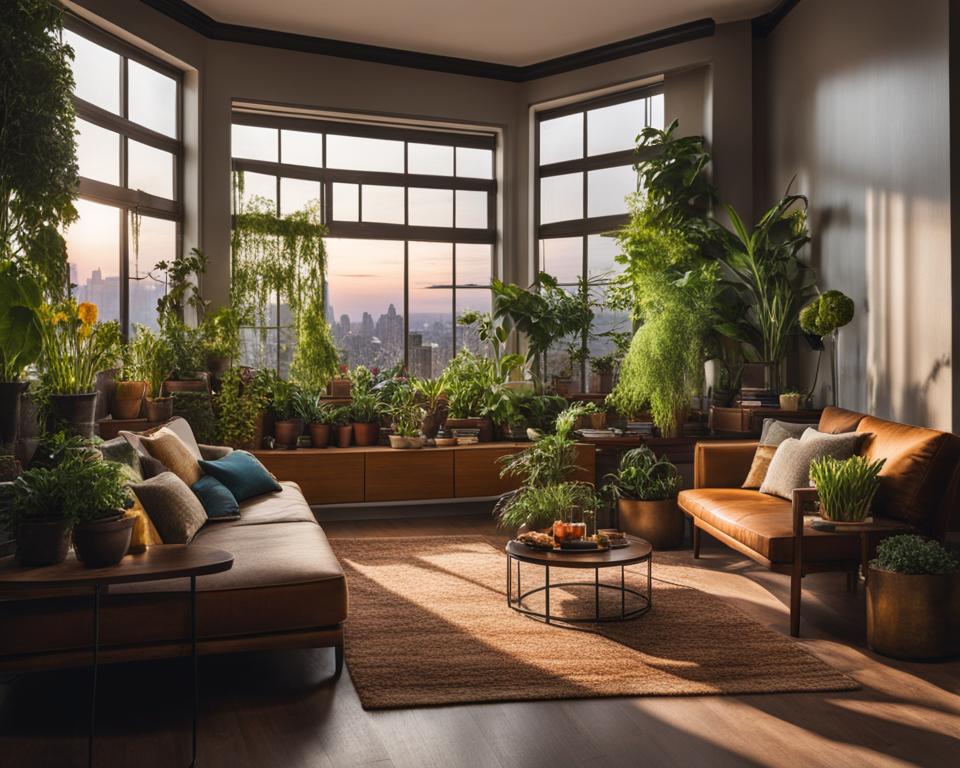
If you’ve decided to delve into the world of indoor gardening, bravo! Transforming your living space into a micro green oasis unlocks a unique set of benefits and constant access to home-grown freshness. Ideal for urban gardening for beginners, indoor gardens thrive with the help of the right setup and care.
Optimal Plants for Indoor Cultivation
When picking plants for your indoor garden, consider those that not only augment your living space aesthetically but also adapt well to indoor environments. Leafy greens such as spinach and kale, along with a variety of herbs like basil and mint, are perfect starters. These plants require relatively less space and can flourish with minimal care.
Leveraging Grow Lights for Year-Round Harvest
No garden spot with adequate sunlight? No problem. Grow lights for plants are a game-changer, providing your flora with all the necessary wavelengths of light to photosynthesize and thrive throughout the year. With these innovative solutions, the climatic and spatial restrictions of urban gardening are a thing of the past.
| Plant Type | Light Requirements | Watering Frequency | Suggested Grow Light Type |
|---|---|---|---|
| Herbs (Basil, Mint) | Medium to High | Every 2-3 days | LED Panel |
| Leafy Greens (Spinach, Kale) | Low to Medium | Every 3-4 days | Fluorescent Tubes |
| Flowering Plants (African Violets) | High | Every 5-7 days | High-Intensity Discharge |
| Fruiting Plants (Cherry Tomatoes) | High | Every 2-3 days | Full Spectrum LED |
Incorporating indoor gardening into your lifestyle not only beautifies your space but also ensures a constant supply of fresh, pesticide-free produce right in the heart of your home. Even for beginners in urban gardening, the use of grow lights can simplify the process and grant a bounty of greenery all year long. Start small, learn as you grow, and enjoy the journey towards a greener, healthier living environment.
Creating Your Own Garden Oasis: Decorating and Design
Stepping into your personal garden retreat offers an essential escape from the bustling urban life. With touches of urban gardening decor, your space can transform into a verdant sanctuary, a true garden oasis that reflects your unique style and brings calm to your busy days. Every choice, from the furniture that invites you to lounge to the choice of planters that add bursts of color, plays a part in crafting this serene outdoor living room.
Adding Personal Touches to Your Urban Garden
Customizing your urban garden creates a sense of intimacy and connection. Think of elements like wind chimes that add soft melodies or string lights that provide a gentle glow. Incorporating various textures with accessories such as cushions or area rugs can also enhance comfort, making your garden a welcoming spot for relaxation and gatherings.
Incorporating Wildlife: Attracting Birds and Butterflies
Attracting wildlife not only supports local ecosystems but also adds a dynamic touch to your urban sanctuary. By planting native flowers and installing bird feeders or a small water feature, you invite birds and butterflies to be regular guests. This interaction with nature doesn’t just offer an aesthetic delight; it provides crucial pollination for your plants, contributing to a healthier and more thriving garden.
| Wildlife-Attracting Feature | Benefits | Examples |
|---|---|---|
| Bird Feeders | Encourages birds to visit, adding natural sounds and movements | Tubular for small seeds, Hopper feeders for mixed seeds |
| Bird Baths | Provides a water source for birds and can attract different species | Stone baths, Hanging baths |
| Butterfly-Friendly Plants | Hosts for caterpillars and nectar sources for butterflies | Milkweed, Coneflowers, Butterfly bush |
| Pollinator Gardens | Supports the lifecycle of pollinating insects; increases plant yields | Combination of native flowers, Shrubs, and Herbs |
Remember, your garden’s design is a reflection of your personal journey in urban gardening. Feel free to experiment and evolve your space, always keeping in mind the balance between beauty and attracting wildlife. With each season, new opportunities arise to enhance your outdoor space, keeping it fresh, vibrant, and ever-inviting.
Urban Gardening Ideas: Charming and Practical Plant Varieties
When you dive into the world of urban gardening, the limitation of space becomes an impetus for creativity. Your balcony, terrace, or even a sunny window ledge can turn into a flourishing garden with the right selection of container-friendly plant varieties. From the robust cherry tomato to the versatile chard, each plant brings its own splash of greenery, and more importantly, a satisfying bounty you’ll reap with pride.
Employing charming gardening ideas doesn’t just add aesthetic appeal to your urban space—it also serves a practical purpose. By focusing on varieties that thrive in containers, you create a truly manageable urban garden, cultivating produce that’s as fresh as it gets. Here are a few urban gardening tips to ensure your high-rise harvest is both abundant and delightful:
- The ever-popular Cherry Tomatoes bring color and tanginess to your urban garden. They’re particularly well-suited to container life as long as they receive plenty of sunlight.
- For a pop of color and a versatile culinary component, Swiss Chard is your go-to green. It grows well in medium-sized pots and can be harvested leaf by leaf to spruce up your dishes.
- Compact varieties of Cucumbers, like the ‘Bush Slicer’, save space without skimping on yield. With a trellis, they can climb upwards, creating a living curtain of green.
- Herbs such as Basil, Mint, and Cilantro are perfect for smaller pots and can grow on a windowsill, offering fragrant and flavorful additions to any meal.
Tending to these container-friendly plants often results in an intimate relationship with your garden as you nurture and watch your plants thrive against the urban backdrop. Remember that even the smallest corner can be transformed with a bit of soil, seeds, and the warmth of your care. Let the plethora of urban gardening ideas inspire you to create a unique and charming green space in the heart of the city.
Harvesting Your Urban Garden: From Plant to Plate
Reaching the zenith of urban gardening is as rewarding as it is scrumptious. With your green thumb and dedication, you’ve watched your plants thrive and are now ready to reap the rewards. The act of harvesting your urban garden not only signifies a successful growth cycle but also heralds the start of enjoying the fruits of your labor, quite literally. Before you delve into the bountiful harvest, it’s essential to know precisely when and how to pick your produce, followed by the best methods for storing and preserving your fresh bounty. Let’s dive into the key elements that will ensure your hard work flourishes beyond the harvest.
Knowing When to Harvest Your Crops
Harvesting at the right moment is critical to capture the true essence and flavor of your crops. Whether it’s the gentle snap of a bean that signals readiness, or the vibrant color of a perfectly ripened tomato, knowing the signs will give you the best quality produce. Use these urban gardening techniques to determine the peak time for picking:
- Check for the characteristic colors indicating ripeness.
- Feel the texture of fruits and vegetables; they should be firm but not hard.
- Follow the size guidelines for each plant species, as some may become woody or less flavorful if overgrown.
Storing and Preserving Your Homegrown Produce
Once you’ve expertly harvested your garden, turning your attention to storing fresh produce effectively will maximize its shelf life. The right storage techniques not only preserve the taste and nutritional value but also help in reducing food waste. Depending on the type of produce, you may have different requirements:
- Refrigerate leafy greens, herbs, and berries to maintain freshness.
- Store root vegetables like carrots and beets in a cool, dark place, possibly using sand to maintain humidity.
- Consider blanching and freezing vegetables for long-term storage.
When it comes to making the most of your harvesting urban garden adventure, the delight doesn’t end at picking. Pickling, jamming, and drying are wonderful ways to preserve your harvest, guaranteeing a taste of summer even in the chill of winter. Engage in these preservation methods to extend your enjoyment:
- Use canning for acidic foods like tomatoes and fruits.
- Pickle cucumbers, peppers, and other crisp veggies for zesty snacks.
- Create dehydrated herbs and fruit slices for a concentrated flavor punch.
With these tips and techniques at your disposal, your urban gardening endeavor will assuredly bring you from seed to sumptuous meals. Remember, the true joy of an urban garden is not just in the nurturing process, but also in the pleasure of tasting your own homegrown delights.
A Step-By-Step Guide to Creating Secluded Spots for Relaxation
Urban dwellers seek respite from the hustle and bustle of city life, and creating secluded garden spots within your urban landscape can be a rewarding venture. Here’s a structured approach to designing your own peaceful garden retreat.
-
Identify the Ideal Location
Locate a spot in your garden that is somewhat hidden from view, be it a corner behind some taller plants or a space that’s naturally shaded by structures. Privacy is paramount.
-
Select Comfortable Seating
Choose seating that invites relaxation. Whether it’s a bench, a hammock, or a lounge chair, ensure it fits into your secluded garden spot perfectly.
-
Surround with Greenery
Encircle your relaxation area with potted plants or climbing vines to build a natural screen. The goal is to separate this area from the rest of the urban space visually.
-
Incorporate Elements of Nature
Add elements like water features, which bring soothing sounds to your space, or a small fire pit for warmth and a focal point.
-
Include Scented Plants
For a multi-sensory experience, introduce fragrant plants like lavender or jasmine near your seating area which will enhance the peaceful retreat with their calming scents.
-
Provide Shade
To ensure comfort, especially in warmer climates, integrate a form of shade—a canopy, pergola, or even a large umbrella will do.
-
Add Personal Touches
Personalize your space with touches like outdoor pillows, string lights, or garden ornaments to make your secluded spot feel even more inviting.
-
Maintain the Space
Regular maintenance ensures that your garden remains a serene sanctuary. Keep it tidy, and manage plant growth to maintain your chosen level of seclusion.
With these steps, you can create a beautiful and peaceful garden retreat that’s uniquely yours. The key is to blend functionality with your own aesthetic, allowing for an inviting and rejuvenating urban gardening experience. A secluded garden spot is more than just an area; it’s a personal haven for you to unwind.
Conclusion
In the heart of the busy city, urban gardening has emerged as a vital lifeline to tranquility and freshness. Throughout our exploration, we’ve uncovered the many joys and rewards such an endeavor provides. Not only have you seen how to transform limited spaces into verdant plots bursting with life, but you’ve also discovered how every plant you nurture is a step towards creating a personal garden oasis—a place where nature thrives against the concrete backdrop. It’s a testament to what you can cultivate with just a bit of soil, seeds, and the sun’s steadfast glow.
Reaping the Benefits of an Urban Oasis
The allure of urban gardening is undeniable. Beyond the tangible yields of plump tomatoes and fragrant herbs, the intangible gains are equally significant. You benefit from the calming green space that is your garden oasis, a small personal Eden that offers solace and a respite from the ceaseless momentum of city life. But, it’s not just your wellbeing that blossoms; you contribute significantly to the environment, fostering biodiversity and promoting sustainability.
Inviting Nature into the Urban Jungle
By embracing the soil and seed, you do more than grow plants—you’re inviting nature into your urban existence. The act of nurturing a garden is a form of kinship with the environment, a symbiotic relationship where every butterfly attracted, and every bird that sings, enriches the urban jungle. In forging this connection, you become a steward of a micro-ecosystem, demonstrating that even in the heart of the city, nature has a place to flourish and inspire. Your commitment to cultivating life amidst skyscrapers is a bold affirmation that greenery and growth have a vital role in urban life. It’s a meaningful way to reinstate a sense of balance, proving that urban gardening benefits are far-reaching—and that the power to create change is, quite literally, in your hands.
FAQ
What are the benefits of urban gardening?
Urban gardening offers a plethora of benefits, including access to fresh vegetables and herbs, improved mental health from connecting with nature, increased biodiversity in cities, and the promotion of a sustainable lifestyle.
How do I start an urban garden as a beginner?
Start by researching the basics of gardening, selecting plans suitable for urban conditions, finding the right spot for your plants considering sunlight and space, and understanding the essentials of container gardening.
Which plants are best suited for city environments?
Plants like basil, spinach, tomatoes, and peppers adapt well to urban settings. Choose plants that align with your available space, sunlight exposure, and personal gardening goals.
How do I find the perfect spot for my urban garden?
Identify areas that receive ample sunlight, considering windowsills, balconies, or community garden spaces. Ensure the chosen location can accommodate your container size and provides good air circulation.
What should I consider when choosing containers for my plants?
Look for containers with proper drainage, consider the material and size based on the plant’s growth needs, and think about the aesthetics to match your personal style and urban surroundings.
Why is proper drainage important in container gardening?
Adequate drainage is crucial to prevent waterlogging, which can lead to root rot and other moisture-related diseases. It ensures that your plants receive the right amount of moisture without the detrimental effects of excess water.
What are some vertical gardening techniques?
Use wall planters, repurposed pallets, or trellises to grow plants upwards, selecting vining and climbing varieties. This approach maximizes the use of vertical space in limited urban environments.
What are the benefits of community gardening?
Community gardening promotes social interactions, provides education on sustainable practices, allows for the exchange of gardening knowledge, and creates a collective green space in urban areas.
How can I get involved in local community gardens?
Reach out to your municipality, search for local garden associations, or connect with neighbors to find existing community gardens. You may also consider starting one by organizing a group of interested participants.
Are windowsills good for gardening?
Yes, windowsills can be ideal for gardening, especially for sun-loving plants. They offer a convenient way to grow herbs and small vegetables within the comfort of your home.
What are the best plants for indoor gardening?
Opt for leafy greens, herbs, and small vegetable varieties that can thrive indoors, such as spinach, chard, lettuce, and mini peppers. They fit well into indoor environments and don’t require as much sunlight as some other plants.
How do I use grow lights for year-round harvesting?
Install grow lights in your indoor garden to simulate natural sunlight and provide your plants with the necessary light spectrum. They enable you to maintain plant growth and productivity, regardless of the season or natural light availability.
How can I add personal touches to my urban garden?
Incorporate decorative elements like colorful planters, garden ornaments, and furniture that reflect your personal style. Add lighting for ambiance and consider DIY projects to make the space uniquely yours.
How can I attract birds and butterflies to my urban garden?
Plant native flowers and foliage that provide nectar and habitat, set up bird feeders and water baths, and avoid using pesticides that can harm these visitors.
What charming and practical plant varieties are there for urban gardening?
Choose compact varieties like cherry tomatoes, chard, and bush cucumbers that can fit within containers and still produce a bountiful harvest in small urban spaces.
How do I know when to harvest my crops in an urban garden?
Monitor your plants for the signs of maturity, such as size, color, and ease of picking. Most vegetables and herbs are best harvested when they’re full-sized but still young and tender.
What are some tips for storing and preserving my homegrown produce?
Use proper storage methods such as refrigeration, drying, canning, or freezing to extend the shelf life of your harvest. Label and date your stored goods, and consider pickling or making preserves for long-term enjoyment.
How can I create secluded spots for relaxation in my urban garden?
Designate areas with comfortable seating surrounded by plants, use screens or trellises for privacy, and add soothing elements like water features or wind chimes to create a peaceful retreat within your garden.
What overall benefits can I reap from an urban oasis?
An urban garden provides a source of fresh food, enhances your living space aesthetically, offers a peaceful spot to unwind, contributes to the urban ecosystem, and promotes a sustainable and healthy lifestyle.
How can I invite nature into my urban jungle?
Plant a variety of species that attract pollinators, provide shelters for wildlife, and use organic gardening practices to ensure a healthy ecosystem for nature’s visitors in your urban garden.
Source Links
- https://revivalrootsnursery.com/blogs/revival-roots-nursery-blog/no-backyard-no-problem-a-guide-to-growing-your-urban-oasis-in-smaller-spaces
- https://www.linkedin.com/pulse/urban-gardening-gen-z-how-create-green-oasis-city-nwabueze-princess
- https://www.houzz.co.uk/magazine/10-ways-to-turn-your-urban-garden-into-a-dreamy-oasis-stsetivw-vs~85189077

